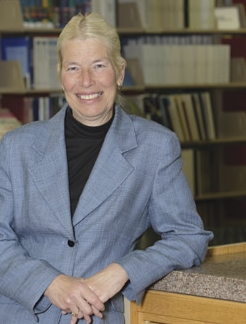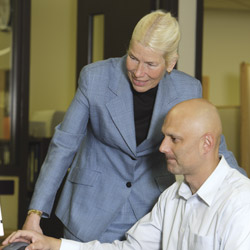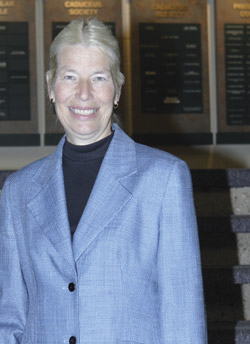
As Regional Dean of the University of Illinois College of Medicine at Peoria (UICOMP), Dr. Sara Rusch guides staff, faculty and students in fulfilling the institution’s mission: to lead collaboration to improve health. The first woman to hold this position, Rusch came to Peoria to do a residency at OSF Saint Francis Medical Center and has held numerous positions within UICOMP over the years, including resident, chief resident, faculty member, department chair and program director. This experience, as well as her commitment to the school’s mission, has put Dr. Rusch in a position to greatly enhance UICOMP’s programs, services and visibility in the community.
Tell us briefly about your background, education and milestones in your career up to this point.
I grew up in Wisconsin and obtained my undergraduate and medical degree from the University of Wisconsin-Madison. I came to Peoria in 1978 to do a residency in Internal Medicine at OSF Saint Francis Medical Center (OSF-SFMC). Peoria was my first choice for this additional training because I recognized that I would receive an excellent education. My goal at that time was to return to Wisconsin and practice primary care general internal medicine. However, during my residency I met and married my husband, Tom Cusack, who is a native Peorian. We’ve both been here ever since!
I love to teach and take care of patients, and my career choices have allowed me to do both. Over time, I’ve increased my administrative role driven by the desire to build new or better programs that would benefit students and patients. I left my position as Chair of the Department of Medicine and took the position of Regional Dean because I thought I could be effective at addressing some of the challenges facing the University of Illinois College of Medicine at Peoria.
What are your responsibilities as Regional Dean?
The Regional Dean is rather like the CEO of any large organization. I’m responsible for moving the organization toward its strategic goals and for making sure that it is fiscally sound. Given the economic challenges in Illinois, accomplishing both at the same time isn’t easy!
How has UICOMP’s role in the community evolved over time?
When this campus opened in the 1970s, UICOMP’s initial role was to train medical students who would choose to practice in Illinois. In the early 1980s we worked with our affiliated hospitals to further develop existing residencies and to create new ones. We currently have nine residencies with OSF-SFMC and one with Methodist Medical Center (MMCI). This enhanced our ability to provide physicians for central Illinois.
In the 1990s, we expanded our faculty and became more involved in direct provision of patient care and increased our involvement with the community in areas pertaining to community health. Over the last decade we have expanded our research, particularly in the areas of cancer and the neurosciences. We have also partnered with the community in projects that would benefit UICOMP and provide an economic advantage for the community.
We’ve been remarkably successful at our core role of training physicians. Roughly 45 percent of physicians in practice here either went to school at the University of Illinois or attended a UICOMP-sponsored residency at OSF-SFMC or MMCI. Our patient care-related revenues are growing as we add physicians to our faculty. We have a very successful research enterprise that has outgrown its current space, and we are working on plans for a Cancer Research Facility. The 110,000-square-foot Illinois Medical Center just opened and provides a teaching site for students. This new facility keeps physicians and patients in downtown Peoria.
What is the current mission of the College?
Our mission is to Lead Collaboration to Improve Health. The College of Medicine has four components of its mission: education, research, patient care and community service/economic development. Although these four areas initially seem quite distinct, they each contribute to the health of the community and are actually quite intertwined.
For instance, the presence of Dr. Jasti Rao’s Cancer Biology Program provides research opportunities that allow Peoria to recruit physician specialists who might otherwise choose to go elsewhere. These specialists not only provide education to students and residents, but also provide patients with specialized medical care. This specialized care draws people to Peoria’s medical facilities, which in turn supports economic development.
In another example, UICOMP’s student education programs train physicians who graduate and then often practice in Peoria or central Illinois. These well-trained physicians provide excellent patient care which directly improves the health of our community. They also provide the physician manpower necessary for the regional hospitals to function. The medical community is in turn a huge economic engine for Peoria.
Whenever possible, I look for projects that benefit all the components of our missio n. As a relatively small campus, our time, energy and resources are limited, and we need to try to have projects that have benefit in multiple areas.
n. As a relatively small campus, our time, energy and resources are limited, and we need to try to have projects that have benefit in multiple areas.
What are your goals for the immediate future of UICOMP in the Peoria community? How about five or 10 years from now?
Since our core mission is education, I’ll start there. I am currently gathering funds for our student learning enhancement project. This project will transform existing UICOMP space into modern, small-group learning areas where our students can use evolving educational technology. This project also supports faculty development. Our teaching styles need to change to take advantage of the electronic age. Concurrently, we need to assure that we teach students communication and teamwork, which is best done in small groups.
Also, within the area of education, we need to work with our partner hospitals, OSF-SFMC and MMCI, to expand residencies and fellowships. We are planning to partner with Methodist to start a residency in psychiatry. OSF-SFMC is also interested in supporting expansion of residencies and the addition of fellowships. The net impact of this will be more better-trained physicians for our region. I’d like to see the new space and the accompanying changes in our teaching style in place within the next two years. Expanding residencies and fellowships is a long-term project, but I hope to see the expansion of psychiatry’s residency program implemented in two years.
Our strategic plan focuses our laboratory research efforts in the areas of neuroscience and cancer biology. By developing a focus, we can get more collaboration among researchers, share sophisticated medical equipment and further develop our research reputation, which in turn, increases grant funding. The medical community already has strong clinical programs in cancer and neuroscience, so we can link our basic science research to patients. Our basic science research programs have brought $22 million to Peoria over the last six years and have resulted in almost 100 published articles in national journals. The current basic science programs have been so successful that we require additional laboratory space. Our planned cancer research facility has pledges of about $9.5 million out of a desired $13 million. We still expect to break ground for this building in 2009, although the economic downturn and lack of a state capital program may present some challenges.
We are also in the early phases of our new health services/outcomes research program. We recognize that our expensive healthcare delivery system doesn’t work effectively for all patients. It is particularly lacking in the areas of prevention and chronic disease management. We have a large uninsured population, increasing numbers of chronically ill older adults, very expensive treatment options, fewer primary care physicians and rising rates of obesity/diabetes. Health services/outcomes research studies how to redesign the delivery of healthcare so that it provides better value. Value takes into account both the improvement in a patient’s health and the costs related to that improvement. The College of Medicine chose to focus on this area because it is so important for our country to address. Peoria is uniquely positioned for this type of research because of the Quality Quest for Health program to transform healthcare, the collaborative attitude of our community agencies, the relatively stable population and our access to rural communities. This research can also occur within any clinical area of medicine, and thus, builds the infrastructure for physician recruitment and residency/fellowship development. This project is a long-term one and may take five to 10 years to fully develop.
Explain how community-wide collaboration plays a vital part in UICOMP’s strategic plan.
Our healthcare system is extremely complex and very competitive. Hospitals, health plans, employers and physician groups share a desire to take good care of the patient, but see almost everything else from different perspectives. Sometimes what is good for one group is bad for another. Patients’ expectations may be different since what patients most often want from their physicians is time/communication, and yet primary care physicians are compensated based on office visits per hour. Creating any substantial change in this system requires collaboration.
Wikipedia defines collaboration as “a process where two or more people or organizations work together toward an intersection of common goals by sharing knowledge, learning and building consensus.” UICOMP by itself does not have the resources to move forward without involving the remainder of the community. Nor, given the complexity of the healthcare system, would we be able to accomplish much without our community partners.
The challenge, of course, is to identify where the intersection of common goals is occurring and then to plan and complete successful projects that move both organizations toward their goals. These collaborative activities must be built on trust, and they take a large amount of time to initiate. Collaboration gets exponentially more complex when larger numbers of organizations are involved.
UICOMP is very dependent on its collaborative relationships with OSF-SFMC and MMCI. Nurturing and strengthening our mutually beneficial shared projects is essential for UICOMP’s sustainability and continued growth.
I firmly believe that collaboration is the only way you can align the community’s resources to improve community health. I believe you start by building or strengthening connections to other organizations, implementing small projects where the mutual benefit is clear, and then slowly increasing the number of collaborators and the complexity of the problem. Obviously this is a long-term process.
The recently opened Illinois Medical Center (IMC) was cited as an example of collaboration. Can you talk more about this?
The Illinois Medical Center is a great example of the challenges and success possible in collaborative efforts. The initial proposal was to build a clinical cancer center where the IMC now stands. This project failed because of an inability to align the needs of physician groups, the community and the University. We simply could not develop a shared vision to make the project work in a timely fashion.
The second attempt was built on what had been learned the previous time. IMC became a collaborative effort of Illinois Gastroenterology Institute, Illinois Lung Institute, Peoria Surgical Group, the City of Peoria and the University of Illinois. This project could not have been accomplished by a single individual or organization. As a result of this collaboration, our students will be better educated, patients will benefit from the proximity of the physicians to downtown Peoria and the hospitals, the city collects tax revenue, and the physicians have an ideal location for their practices. This is a true win-win situation.
This is a two-fold lesson. Collaborations can accomplish a great deal, and they aren’t always successful on the first try!
What are the most commonly asked questions of incoming or prospective students?
Students are often surprised by all that Peoria has to offer. Their questions are usually about whether their education here will prepare them for their desired careers and whether the Peoria community is a good place to live. It is always easy to answer both questions with a resounding “yes.”
Students are always impressed when they learn about the Peoria medical community. Before they arrive, they don’t realize that our medical community can match or exceed what is available in Chicago. They are pleased to learn that Peoria students perform well on national exams and are accepted into the most competitive residencies. Although some of them miss the big cities they grew up in, most of them are impressed with Peoria as a place to live.
The healthcare industry is poised to create more jobs in the next decade than any other industry. What is the best way to inspire young people to enter this field?
I think young people enter medical fields primarily because they have an altruistic desire to take care of people and have an interest in the sciences and problem solving. Of course, the presence of jobs and reasonable salaries also attracts students. This interest can be fostered by increasing high school student exposure to the science of medicine and making it clear that a medical career is possible for them.
One of the main limiting factors in training health professionals is the lack of resources to provide their education. There are many more qualified applicants to medical school than there are places to train them. The same is true of nursing schools and other medical professional schools. UIC would like to educate more medical students so that we can address expected physician shortages, and we have proposed an increase in our medical student complement to the State. We cannot increase our number of students without state funding, and so far, no such increase has occurred.
What are the most challenging issues faced by the College today?
Fiscal issues are a huge concern for UICOMP. State support has been consistently dwindling. Every time medical school tuition increases, the state support decreases. The combination of tuition and state dollars Peoria receives has not risen for more than ten years. In fact, this year we have already had a three percent decrease in the state and tuition dollars UICOMP receives, and we expect to hear about further decreases. We have become increasingly reliant on patient care dollars, service contracts with our affiliated hospitals, research grants and philanthropy.
This year’s budget projects that only 16 percent of our total budget will come from state or tuition dollars. Adequate state and tuition dollars are essential to support the infrastructure of the medical school and to protect teaching time for faculty.
The other challenging issue is the level of competition within the medical community. UICOMP believes that the educational needs of students and residents should be a determining factor in the design of our collaborative efforts. Balancing educational needs versus the competitive needs of physician groups or institutions can be a real challenge. 
You’ve been quoted as saying “We can dream about what we can create, not about what is available at the moment.” Please explain what your dreams are.
I truly believe that through collaboration, UICOMP and the healthcare community can improve the health of the people of central Illinois. I can see how teaching, patient care, research and community service could combine to make Peoria an ideal place to practice and learn medicine, to receive exceptional patient care, and to make us a healthier community through prevention.
Building a dream is like working a puzzle. You need to have the big picture of what it will look like. Then you start to put the pieces together, beginning with the easy ones on the edge. You find that some of the pieces you think will fit together do not. Other pieces surprise you and fit together perfectly. Each piece adds to the puzzle and as the picture gets clearer, blocks of integrated puzzle pieces can combine and the work goes faster. Over time the completed picture successfully emerges.
Some days, when you are buried in budgets, human resource issues and administrative barriers, you can only see the problems of the moment. If, instead, you keep seeing the possibilities and dreaming about what you can create, then you have the energy to keep striving to add another piece to the puzzle. iBi

